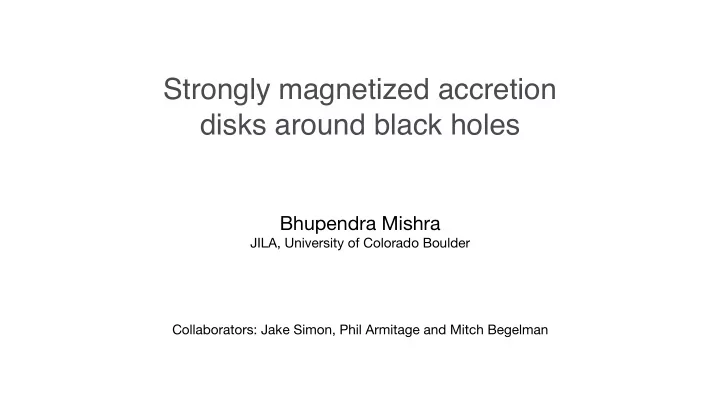

Strongly magnetized accretion disks around black holes Bhupendra Mishra JILA, University of Colorado Boulder Collaborators: Jake Simon, Phil Armitage and Mitch Begelman
Types of Accretion disks Geometrically: Thin disk Cold, close to sub-Eddington, optically thick - Shakura & Sunyaev 1973, Novikov & Thorne 1973, Lynden-Bell & Pringle 1974 Slim disk Cold, Eddington or super-Eddington, optically thick, advection dominated - Katz 1977, Begelman 1979, Begelman & Meier 1982, Abramowicz et al. 1988 Thick disk - Optically thin, advection dominated Abramowicz, Jaroszynski, Sikora 1978, Narayan & Yi 1994 Slim Thick BH BH Thin BH
Geometrically thin disks H/r ⌧ 1 Radiatively e ffi cient BH P rad � P gas BH α = < T r φ > < P gas > Shakura & Sunyaev 1973 BM+ 2016
Instabilities Hydrodynamical: Thermal Instability Viscous Instability BM+ 2016
Local simulations Jiang et al. 2013
Global simulation P rad >> P gas Unstable branch t 0 t f P rad > > P gas h c n a r b e l b a t S R = 10 M , α = 0 . 02 BM+ 2016
Open Questions • Why do we find thermally unstable disks in simulations ? What can stabilize them ? Perhaps magnetic field (Sàdowski 2016) • What are e ff ects of net vertical magnetic field in global simulations? • Can we learn something about AGN accretion ?
β p ~ 10 2 β p > 10 5 β p < 1 MRI active MRI suppressed MRI active β t ~ 10 2 β t < 1 weakly magnetized strongly magnetized magnetically arrested increasing poloidal magnetic flux Sketch: Phil Armitage
Local simulations 0 50 100 150 200 Salvesen et al. 2016
Global simulations Zhu & Stone 2018
Initial setup Mass Density ✓ R ◆ q ρ 0 ( R, z = 0) = ρ 0 ( R 0 , z = 0) R 0 GM ✓ ◆� R 2 + z 2 − 1 1 ρ ( R, z ) = ρ ( R, z = 0) exp √ c 2 R s ✓ c s # 1 / 2 " ◆ 2 qR v φ ( R, z ) = v K ( p + q ) + 1 + q − √ R 2 + z 2 v φ ,k
Static mesh refinement
Magnetically elevated disks β i = 100 β i = 300 β i = 1000
Elevated Accretion B φ ρ v r
Turbulent viscosity
Spiral structures β i = 100 β i = 300 β i = 1000
Spiral structures
Conclusions • Accretion disks get elevated and inflow occurs in higher altitudes • Qualitative agreement with local shearing box simulations • Logarithmic spiral structures • Future work: include radiative transfer
Thank you
Recommend
More recommend